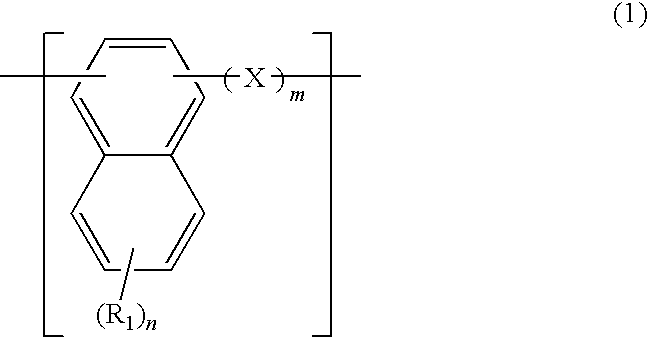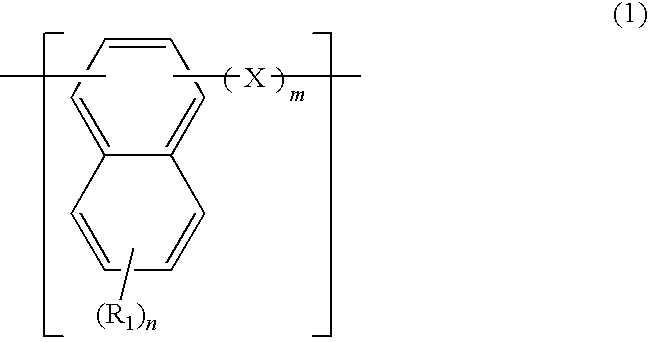Composition for forming lower layer film and pattern forming method
a technology of resist and lower layer film, applied in the direction of photosensitive materials, instruments, photomechanical equipment, etc., can solve the problems of overetching and interskimming produced in the above-mentioned resist lower layer film, and achieve excellent pattern transfer performance, superior intermixing prevention effect, and excellent pattern transfer performan
- Summary
- Abstract
- Description
- Claims
- Application Information
AI Technical Summary
Benefits of technology
Problems solved by technology
Method used
Image
Examples
synthesis example 1
Synthesis of Polymer (A-1)
[0092]A reactor equipped with a condenser, a thermometer, and a stirrer was charged with 100 parts of 1-naphthol, 100 parts of propylene glycol monomethyl ether acetate, and 50 parts of paraformaldehyde. After the addition of two parts of oxalic acid, the mixture was heated to 12° C. and reacted for five hours while dehydrating. After cooling to 100° C., 1 part of paratoluenesulfonic acid was added. 40 parts of styrene was added dropwise to the reaction mixture at 120° C. over 60 minutes. After allowing the mixture to stand at 120° C. for four hours, the mixture was reacted at 140° C. for two hours to obtain the polymer (A-1).
synthesis example 2
Synthesis of Polymer (A-2)
[0093]A reactor equipped with a condenser, a thermometer, and a stirrer was charged with 100 parts of 1-naphthol, 100 parts of propylene glycol monomethyl ether acetate, and 1 part of paratoluenesulfonic acid (PTSA). After heating to 120° C., 40 parts of divinylbenzene (DVB) was added at 120° C. over 30 minutes. After allowing the mixture to stand at 120° C. for two hours, the mixture was heated to 140° C. and reacted for three hours. The reaction mixture was then cooled to 100° C., followed by the addition of 1 part of PTSA. Forty parts of styrene was added dropwise to the reaction mixture at 120° C. over 60 minutes. After allowing the mixture to stand at 120° C. for four hours, the mixture was reacted at 140° C. for two hours to obtain the polymer (A-2).
synthesis example 3
Synthesis of Polymer (A-3)
[0094]A reactor equipped with a condenser, a thermometer, and a stirrer was charged with 100 parts of 1-naphthol, 100 parts of propylene glycol monomethyl ether acetate, and 1 part of paratoluenesulfonic acid (PTSA). After heating to 120° C., 30 parts of divinylbenzene (DVB) and 20 parts of furfural were added dropwise at 120° C. over 30 minutes. After allowing the mixture to stand at 120° C. for two hours, the mixture was heated to 140° C. and reacted for three hours. The reaction mixture was cooled to 100° C., followed by the addition of 1 part of PTSA. Forty parts of styrene was added dropwise to the reaction mixture at 120° C. over 60 minutes. After allowing the mixture to stand at 120° C. for four hours, the mixture was reacted at 140° C. for two hours to obtain the polymer (A-3).
Measurement of Molecular Weight
[0095]The Mw of the polymers obtained in Synthesis Examples 1 to 3 was measured by gel permeation chromatography (GPC) using monodisperse polyst...
PUM
| Property | Measurement | Unit |
|---|---|---|
| temperature | aaaaa | aaaaa |
| mol % | aaaaa | aaaaa |
| mass % | aaaaa | aaaaa |
Abstract
Description
Claims
Application Information
 Login to View More
Login to View More - R&D
- Intellectual Property
- Life Sciences
- Materials
- Tech Scout
- Unparalleled Data Quality
- Higher Quality Content
- 60% Fewer Hallucinations
Browse by: Latest US Patents, China's latest patents, Technical Efficacy Thesaurus, Application Domain, Technology Topic, Popular Technical Reports.
© 2025 PatSnap. All rights reserved.Legal|Privacy policy|Modern Slavery Act Transparency Statement|Sitemap|About US| Contact US: help@patsnap.com



